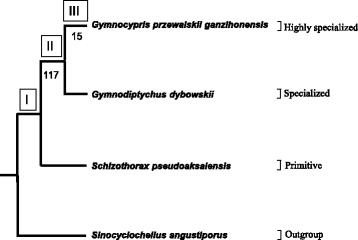Genome-wide identification of genes probably relevant to the adaptation of schizothoracins (Teleostei: Cypriniformes) to the uplift of the Qinghai-Tibet Plateau
- PMID: 28427344
- PMCID: PMC5397779
- DOI: 10.1186/s12864-017-3703-9
Genome-wide identification of genes probably relevant to the adaptation of schizothoracins (Teleostei: Cypriniformes) to the uplift of the Qinghai-Tibet Plateau
Abstract
Background: Molecular adaptation to the severe environments present during the uplift of the Qinghai-Tibet Plateau has attracted the attention of researchers. The divergence of the three specialization groups of schizothoracins (Primitive, Specialized and Highly Specialized) may correspond to the three phases of plateau uplift. Based on the transcripts of representative species of the three specialized groups and an outgroup, genes in schizothoracins that may have played important roles during the adaptation to new environments were investigated.
Results: The contigs of Gymnodiptychus dybowskii and Schizothorax pseudaksaiensis were compared with those of Gymnocypris przewalskii ganzihonensis and the outgroup Sinocyclocheilus angustiporus, and 5,894 ortholog groups with an alignment length longer than 90 nt after deleting gaps were retained. Evolutionary analyses indicated that the average evolutionary rate of the branch leading to the Specialized group was faster than that of the branch leading to the Highly Specialized group. Moreover, the numbers of gene categories in which more than half of the genes evolved faster than the average values of the genome were 117 and 15 along the branches leading to the Specialized and Highly Specialized groups, respectively. A total of 40, 36, and 55 genes were likely subject to positive selection along the branches leading to the Primitive, Specialized and Highly Specialized groups, respectively, and many of these genes are likely relevant to adaptation to the cold temperatures, low oxygen concentrations, and strong ultraviolet radiation that result from elevation.
Conclusions: By selecting representative species of the three groups of schizothoracins and applying next-generation sequencing technology, several candidate genes corresponding to adaptation to the three phases of plateau uplift were identified. Some of the genes identified in this report that were likely subject to positive selection are good candidates for subsequent evolutionary and functional analyses of adaptation to high altitude.
Keywords: High-altitude adaptation; Polyploid; Positive selection; Schizothoracins.
Figures


Similar articles
-
Whole-genome relaxed selection and molecular constraints in Triplophysa under adapted Qinghai-Tibetan Plateau.BMC Genomics. 2025 Feb 10;26(1):123. doi: 10.1186/s12864-025-11290-w. BMC Genomics. 2025. PMID: 39924476 Free PMC article.
-
Cyprininae phylogeny revealed independent origins of the Tibetan Plateau endemic polyploid cyprinids and their diversifications related to the Neogene uplift of the plateau.Sci China Life Sci. 2016 Nov;59(11):1149-1165. doi: 10.1007/s11427-016-0007-7. Epub 2016 Sep 20. Sci China Life Sci. 2016. PMID: 27646682
-
Genome of Crucihimalaya himalaica, a close relative of Arabidopsis, shows ecological adaptation to high altitude.Proc Natl Acad Sci U S A. 2019 Apr 2;116(14):7137-7146. doi: 10.1073/pnas.1817580116. Epub 2019 Mar 20. Proc Natl Acad Sci U S A. 2019. PMID: 30894495 Free PMC article.
-
Adaptation of High-Altitude Plants to Plateau Abiotic Stresses: A Case Study of the Qinghai-Tibet Plateau.Int J Mol Sci. 2025 Mar 4;26(5):2292. doi: 10.3390/ijms26052292. Int J Mol Sci. 2025. PMID: 40076909 Free PMC article. Review.
-
Adaptive genetic changes related to haemoglobin concentration in native high-altitude Tibetans.Exp Physiol. 2015 Nov;100(11):1263-8. doi: 10.1113/EP085035. Exp Physiol. 2015. PMID: 26454145 Review.
Cited by
-
Full-length transcript sequencing accelerates the transcriptome research of Gymnocypris namensis, an iconic fish of the Tibetan Plateau.Sci Rep. 2020 Jun 15;10(1):9668. doi: 10.1038/s41598-020-66582-w. Sci Rep. 2020. PMID: 32541658 Free PMC article.
-
Plateau Grass and Greenhouse Flower? Distinct Genetic Basis of Closely Related Toad Tadpoles Respectively Adapted to High Altitude and Karst Caves.Genes (Basel). 2020 Jan 22;11(2):123. doi: 10.3390/genes11020123. Genes (Basel). 2020. PMID: 31979140 Free PMC article.
-
Substantially adaptive potential in polyploid cyprinid fishes: evidence from biogeographic, phylogenetic and genomic studies.Proc Biol Sci. 2020 Feb 12;287(1920):20193008. doi: 10.1098/rspb.2019.3008. Epub 2020 Feb 12. Proc Biol Sci. 2020. PMID: 32075533 Free PMC article.
-
Parallel introgression, not recurrent emergence, explains apparent elevational ecotypes of polyploid Himalayan snowtrout.R Soc Open Sci. 2021 Oct 27;8(10):210727. doi: 10.1098/rsos.210727. eCollection 2021 Oct. R Soc Open Sci. 2021. PMID: 34729207 Free PMC article.
-
De novo assembly of Schizothorax waltoni transcriptome to identify immune-related genes and microsatellite markers.RSC Adv. 2018 Apr 16;8(25):13945-13953. doi: 10.1039/c8ra00619a. eCollection 2018 Apr 11. RSC Adv. 2018. PMID: 35539357 Free PMC article.
References
-
- Bigham A, Bauchet M, Pinto D, Mao X, Akey JM, Mei R, Scherer SW, Julian CG, Wilson MJ, López Herráez D, et al. Identifying signatures of natural selection in Tibetan and Andean populations using dense Genome Scan Data. PLoS Genet. 2010;6(9):e1001116. doi: 10.1371/journal.pgen.1001116. - DOI - PMC - PubMed
Publication types
MeSH terms
LinkOut - more resources
Full Text Sources
Other Literature Sources
Research Materials

